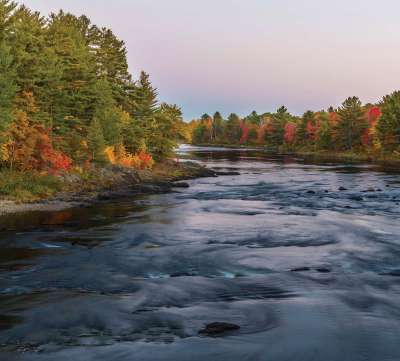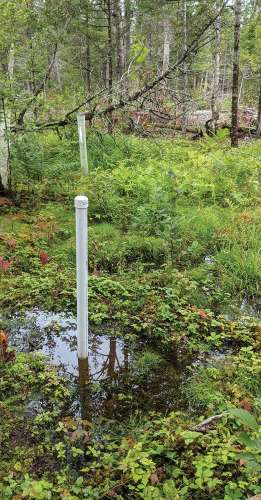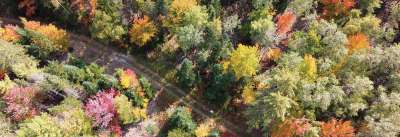Each fall, as days grow shorter and the sun dips lower in the sky, the last of the year’s run of Atlantic salmon swim through the cold waters of the Penobscot River and its tributaries, sweeping tails against gravelly sections of riverbed. Since spring, the fish – part of the distinct Gulf of Maine population that is listed under the Endangered Species Act – have traveled up from the sea to carve out nests for eggs. Some of these adults will live to see the entire process through and return to ocean waters, while others will get caught up in the talons of eagles or ospreys, their carcasses tossed to the forest floor. Ocean nutrients locked in the salmon’s bones and flesh will seep out of their decaying bodies and into the ground, feeding trees along the river’s bank. Those trees, in turn, will shade the river next summer, keeping the fish cool and healthy.
At the same time the salmon are swimming upriver, juvenile river herring are swimming down from ponds and streams in the millions, easy prey and a rich food source for heron, river otter, and other wildlife. As the herring enter the estuaries along Penobscot Bay, they bring new protein into marine food webs, completing a mutually beneficial exchange between river, forest, and ocean.
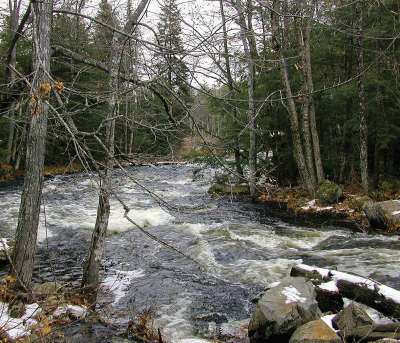
For millennia, Penobscot River waters ran thick with these fish, along with American eel, sea lamprey, and other species that have provided sustenance for members of the Penobscot Nation and their ancestors who have lived along these shores for more than 10,000 years. “The tribe owes its existence to the river,” John Banks, a member of the tribe and its longtime director of natural resources, said in an interview this past spring. “It made life possible.”
As European settlers congregated here and saw ship masts in pine stands, the river and its watershed transformed. Trees were plucked and pushed into channels to feed mills that powered local economies. Stray logs sank to the river’s bottom, depleting oxygen levels as they decomposed. Rootless banks crumbled and sent silt into channels, clouding currents and depleting water quality for the fish on which the Penobscot Nation relied. By the mid-19th century, the region had become the largest source of lumber in the world, and a radically altered landscape.
While the legacy of all this activity persists, people’s growing concern for the environment over the past 50 years helped bring in a new era of more sustainably-minded management practices that are more compatible with the long-term health of the river and its watershed. Beyond baseline measures now required by federal and state laws – for example, limiting cutting along riverbanks – many landowners and foresters are choosing to take extra precautions to protect waterways, and more than half of Maine’s 16 million acres of timberlands are now enrolled in one of several sustainable forestry certification systems. Such shifts in forest management are not only helping to improve water quality but are also strengthening the quality of the stands themselves in ways that may offer economic and ecological benefits for generations to come.
This forward-thinking approach gives Banks hope for the future of the river, the wildlife, and the people who depend on it. “Things are turning around,” he said. “It’s being managed overall more wisely now.”
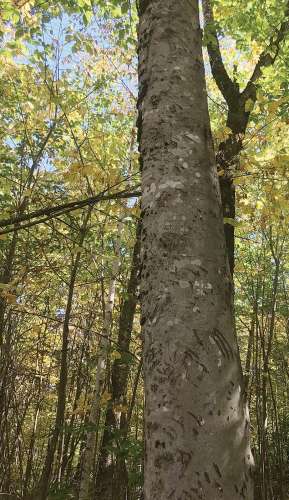
Through the Heart of Maine
The Penobscot River flows through the center of Maine, collecting its waters from four main tributaries that expand across nearly one-third of the state. The upper reaches of the river sink swiftly over steep terrain that gives way to calmer stretches that then intensify again before emptying out into Penobscot Bay, more than 260 miles from its headwaters. With forested tendrils that wind through more than 8,500 square miles, it is considered New England’s second largest river system.
Amid centuries of landscape change and timber harvests, a variety of creatures continue to make a living in this watershed. Freshwater mussels cluster on the riverbed, otters tumble through currents, and pygmy snaketails – a rare riverine dragonfly species – dart across the water’s surface. Where old river channels have left depressions in the forest floor, vernal pools swell each spring and offer breeding grounds for frogs and salamanders. Eagles, ospreys, and kingfishers hunt from above as fish swim upstream.
Conservation groups and foresters agree that logging can coexist within this rebounding ecosystem, so long as certain measures are taken to maintain water quality and wildlife habitat. Such measures can include building sturdy road-stream crossings to limit sediment erosion into waterways, and maintaining wide enough harvest buffers alongside riverbanks to keep shorelines shady and water temperatures cool and habitable.
These are the types of practices that Russell Roy, the Penobscot Nation’s recently retired forest manager, worked into management plans for the 50,000 acres of timberlands the tribe manages in the Penobscot River watershed. “Their number one goal is to preserve and protect water quality, that’s first and foremost,” he said of the tribe’s forestry approach. The tribe continues to evolve its practices to better serve the ecosystem, Roy said, including by using GPS mapping tools to more easily avoid vernal pools and other sensitive habitats while routing paths to harvest sites. The tribe’s new forest manager, Chuck Loring, Jr., will implement the forest management plans Roy established, which were approved by the tribal council.
Those plans include managing stands for a minimum 90-year rotation, typically making entries every 30 to 40 years before turning the stand over from merchantable saw timber to release young trees in the understory that developed after a shelterwood harvest, and “no harvesting is allowed in any unique natural areas, such as those having historic or cultural significance, as identified by tribal council,” Loring said.
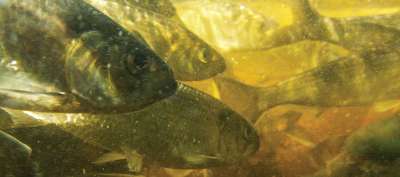
Clearcuts are reserved for small areas spanning 8 acres or less, and are strategically placed to create browse for moose and to enhance tree species composition in areas where wood quality is low. In an effort to maintain water quality, the tribe also protects an additional 250 feet beyond the standard no harvest zone along lakes, ponds, and rivers as required by state law. “We can do a restricted harvest in these areas but we typically don’t,” Loring said.
Other groups are taking proactive measures to protect water quality, including Seven Islands Land Company, a private land and timber management company based in Bangor that manages nearly 1 million acres across the state. When woodland manager Nick Baser first got started with the company about 15 years ago, he says that they were not as tuned in to the ways their thousands of road-stream crossings impacted water quality within the Penobscot River watershed. “You put the road in where it made the most sense and you sized the culvert or the type of crossing to the situation,” he said. But that mindset has shifted over the years. They’re now certified by two sustainable forestry certification systems and are prioritizing building stream-crossings in ways that limit erosion and allow fish and other wildlife to easily travel upstream. “Now there is definitely an emphasis on fish habitat and the importance of that connectivity,” Baser said.
Seven Islands was one of dozens of landowners and organizations to team up with The Nature Conservancy in recent years to inventory road-stream crossings across the entire state, in an effort to identify areas in need of repair for the sake of water quality and habitat connectivity. With 26,000 data points collected over the course of 13 years, The Nature Conservancy is now working with state, federal, tribal, and nonprofit partners to help landowners make necessary upgrades. “They are allowing the streams to act more like nature intended,” said Molly Payne Wynne, the freshwater program director at The Nature Conservancy in Maine who was involved in the inventory project.
The benefits of this inventory will ripple across the entire state, but have potential for particularly powerful results within the Penobscot River watershed, where the recent removal of two major dams in Veazie and Old Town and other improvements to fish passage have greatly enhanced access for native sea-run fish to the upper watershed. “Now we know for a fact that we can make really impressive gains in habitat connectivity,” Payne Wynne said.
But once these fish reach their upriver destinations, they’ll still need access to healthy habitat – and the quality of that habitat will depend largely on the quality of the forests they encounter along the river’s banks.
Thinking Differently About Forest Health
The legacy of unsustainable logging in the Penobscot River watershed has made some stands more vulnerable to pests and disease, weakening the integrity of some stream banks and increasing sediment loads in waterways that can clog fish gills and jeopardize water quality in other ways. Laura Kenefic, a research forester with the U.S. Forest Service who works in the Penobscot Experimental Forest in the town of Bradley, says that in places where slow-growing, long-lived red spruce has been selectively harvested, for example, balsam fir has now largely taken over. This species is susceptible to the balsam woolly adelgid, an insect pest that has become more prevalent in inland regions of Maine in recent years, potentially due to climate change. As these stands succumb to such stressors and die over time, their root systems break down and the stream banks they once held in place begin to deteriorate.
Maintaining and managing for a more diverse array of trees, in terms of both age and species, can help relieve pressure on stands and establish a more balanced forest ecosystem that is biologically richer and more resilient to pests and disease. Kenefic plans to encourage managing for diversity in an updated forest management guide for northern conifer forests that she’s working to revise for the first time since the 1960s – a project on which she is partnering with John Banks, to incorporate the tribe’s perspective and to ensure that forestry decisions reflect the forest’s role in the broader ecosystem rather than treating it as an isolated resource.
“We can learn a lot from the tribes in Maine about other ways of understanding and connecting with the forest that might help us think differently about how we apply our forest management,” Kenefic said.
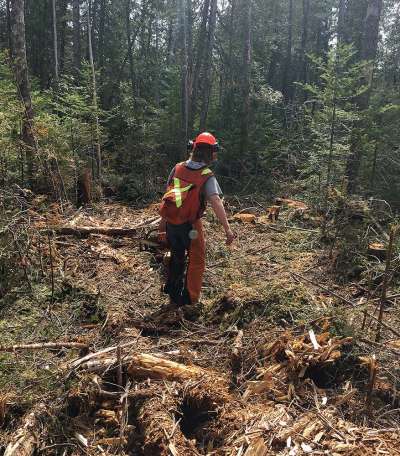
Changing Ownership Leads to New Opportunities
During the past 20 years, land ownership in the Penobscot River watershed has shifted to increased ownership by conservation groups, which has helped to expand the implementation of sustainable forestry methods that prioritize water quality. Such organizations often have access to grant funds or private donations that can help support such efforts, including culvert improvements and forest management practices that promote longer-term growth. The Nature Conservancy’s 12,700-acre Bradley Sunkhaze Preserve just north of the Penobscot Experimental Forest, for example, is being managed for old-growth forest. The preserve, established in 2015, connects the Sunkhaze Meadows National Wildlife Refuge and state land managed for wildlife and wetland values; these properties combined help to maintain water quality in Sunkhaze Stream, a tributary of the Penobscot River. In 2016, Elliotsville Foundation, Inc. donated 87,500 acres of land to the United States to create the Katahdin Woods and Waters National Monument, including 30 miles of shoreline along the East Branch of the Penobscot River that contains important habitat for salmon and river herring. The Monument lands are within traditional territory of the Penobscot Nation. This year, the foundation gave the Penobscot Nation a 735-acre property that connects two parcels owned by the tribe along the Pleasant River, a tributary of the Penobscot River that is considered critical salmon habitat.
These shifts in land ownership in the upper watershed have occurred in part due to the bankruptcy of Great Northern Paper Company, a pulp and paper manufacturer that owned more than 2 million acres of timberlands across the state and operated a mill in the town of Millinocket for more than a century before closing down in 2014. The mill closure left a considerable gap in the region’s economy that has slowly but steadily begun to fill in with other, more diversified business ventures supported by a mix of public and private funding. For example, at the site of the mill on the West Branch of the Penobscot River, Californian company Nautilus Data Technologies has recently announced plans for a 60-megawatt data center. Diversification also includes a growing outdoor tourism industry – visitors travel through Millinocket to reach Baxter State Park and the Katahdin Woods and Waters National Monument, drawn to the region’s remote and expansive wilderness. Leaving forests intact and harvesting with recreational values in mind can help fuel regional economies by maintaining the region’s appeal to paddlers, hikers, bikers, and other outdoor enthusiasts who flock here.
Beyond tourism, the wood-products industry has also begun to pivot and take new forms along the river, including a modular home manufacturer slated to set up shop in Millinocket, with a focus on sustainable building. “Other facilities are now seeing an opportunity to come back into the watershed to make new uses of the wood that’s there,” said Kenneth Laustsen, a retired forester who worked for the Great Northern Paper Company for more than 20 years before transitioning to a career with the Maine Forest Service. He now consults with an initiative called Local Wood WORKS that helps consumers source wood products that have been sustainably harvested and processed from wood grown in Maine or elsewhere in the Northeast, with an aim to strengthen the health of local businesses and forested land.
Laustsen noted that the environmental awareness among foresters today far exceeds what he experienced when he entered the workforce 50 years ago. “What my college education was in the early ’70s and what I now have to think about if I plan a harvest, it’s night and day,” he said.
John Banks sees these changes manifesting not only in land conservation and forestry groups, but also in those studying forests and best management practices in academia, with an expanding intersection between Western science and traditional ecological knowledge that takes the health of the entire ecosystem into account. “Those two areas are coming together,” he said. He’s hopeful that there will be continued growth in people’s appreciation of the river and the land around it, so that those living here generations from now will have access to its resources and will find refuge in its beauty.
“We’re part of the river. It’s our home,” Banks said. “We should work to improve it and not inadvertently destroy it.”
This article was made possible by a grant from The Maine Timberlands Charitable Trust.


